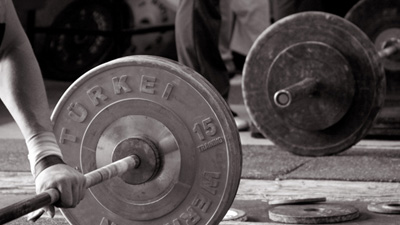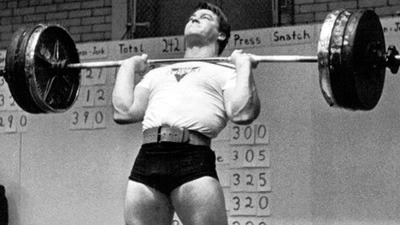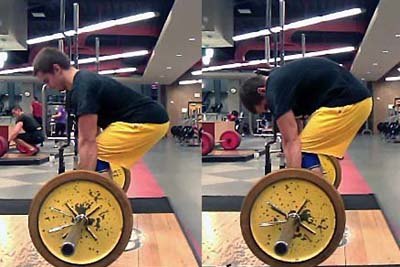There’s a lot of factors that go into your progress at the gym.
When it comes to getting stronger, everything from you diet to your routine to your sleeping habits come into play.
Yes, getting stronger and building muscle are inherently linked together. Once you’ve maximized your neural gains—the progress you can make as a result of your nervous system becoming more adept at performing a particular exercise—the only way to get stronger is by building more muscle.
And, vice versa, getting stronger is the primary stimulus your body needs to synthesize new muscle tissue.
While eating a proper diet and getting quality rest are both absolutely crucial for bulking up and getting stronger, in this article I’ll talk about specific training techniques you should be using.
1. Squeeze the shit out of the bar

The strength of your grip is more important than you may think
For just about every exercise I can think of, it pays to grip the bar as firmly as possible.
When it comes to improving your bench press, this will help keep the wrists straight, protecting them from injury, and it will help you fully contract your triceps, chest, and lats for a stronger and more stable press. When it comes to improving your squat, this will help you keep your chest open and contract your lats for a more stable and safe squat. If you’re curling it will keep your from curling our wrists instead of our arms and keep your wrists safer as a result.
One exception I can think of for this is if you’re doing an olympic lift or front squat and holding the bar in the rack position. In this case your grip is loose to allow your elbows to be held high in front of you.
2. Take huge breaths
Taking huge breaths that fill up your stomach and chest with air is doubly important:
- It will expand your chest and allow you to hold your shoulder blades back in a neutral position so that you can keep an strong, straight back
- It will make contracting your abdominal muscles easier, as breathing into your stomach forces you to utilize the full length of your diaphragm
By taking advantage of these two factors you’ll maintain better posture and a tighter core – adding more stability and strength to your exercises.
Note: It’s also important to time your breaths correctly. Inhaling at the beginning of a repetition and holding it in to maintain tension until you near the completion of the repetition.
3. Focus on compound movements

Compound movements like the overhead press are best for building muscle
Compound movements are movements that recruit more than one major muscle group to complete. Some common examples are squats, deadlifts, presses, and pull-ups.
These are best because they allow you to move the most weight – you simply can’t curl as much as you can row, for example. And using more weight is what allows you to get stronger… and as we talked about in the intro, getting stronger is what allows you to build muscle.
Around 75% of your time in the gym should be spend doing these types of movements. The other 25% can be used for isolation movements that work your arms and abs. And this is why I advocate full-body routines that focus on the compound lifts.
4. Track your progress
This point is simple yet often ignored. Keeping track of how much weight you lifted and for how many reps is extremely simple. Yet without doing it you have no way of knowing if you’re making progress. And you have no idea what you should be aiming to lift each time you’re in the gym.
In short, this is probably the biggest mistake you can on your muscle building journey, especially make given how easy it is.
5. Keep your back straight

Keeping your back straight is crucial, and not just when deadlifting
Keeping a straight back is a key part of nearly every exercise.
Allow your back to round (as seen above on the right) is a quick way to herniate a disc and get hurt. Not to mention it also will prevent you from aligning your body in an optimal position to move the most weight. By breathing correctly (as mentioned above) and training yourself to keep your shoulder blades back and your stomach tight you should be able to maintain an erect back as you execute most movements.
6. Use an explosive repetition tempo
When it comes to repetition tempo, I recommend lifting the weight as fast as possible… on the way up at least (during the concentric portion of the lift). On the way down you should lower the weight (if you’re doing an exercise like the bench press or deadlift) or your body (if you’re doing an exercise like a squat or pull-up) in a slow, controlled manner.
Using this tempo (fast on the way up, slow on the way down) accomplishes two things:
- By lowering the weight slowly, you ensure that you’re using a weight that’s not too heavy for you
- By lifting the weight explosively, you activate a maximum number of motor units and muscle fibers, and this leads to optimal muscle growth and strength increase
Read More: The Top 3 Muscle Building Mistakes Men Make
didnt know 6, 2 and especially 1. will try those out, thanks for sharing!
killer stuff as always.
Lifting “explosively” maximizes risk of injury, as the peak loads can be much higher than the weight. It also maximizes inertia, so that for at least some of the range of motion the load is lower than the weight.
Stand on a scale and squat slowly. The scale will read your weight through the entire range of motion. Now do it again, but “explode” on the way up. The scale will read higher than your weight for a moment, then lighter than your weight. “Explode” enough and the scale will read zero at the end of motion.
Or tie a length of 5 lb. test line to a 5 lb. weight. Lift slow and controlled and you lift the weight. Lift “explosively” and the weight doesn’t move, you just snap the line.
Muscle fibers are recruited in a cascade fashion, from weakest to strongest. Maximum fibers are recruited by lifting in a controlled manner to, or near to, temporary muscular failure.
The entire idea of lifting “explosively” is the product of a single con artist, Alvin Roy:
I was about to say. Explosive moves are best for body weight exercises. You know the whole plyometrics stuff. Sprinting jumping. I don’t think this writer really knows what he’s talking about.
Don’t mean to hate. But his articles seem more suited to men’s health or some other blue pill shit.
Body weight trainers can use fast movements to increase the force produced without needing to add weight, but as per the above, it is not optimal. It’s better to decrease the leverage or increase the angle (push ups with your feet raised).*
If you wish to maximize your jump height, you are going to have to practice jumping, but the goal of jumping is to produce the maximum possible negative weight.
That is not the goal of strength training, and strength training alone will increase your jump height, even without jump training.
*Or, if conditions allow, give up being a purist and just add some weight.
I would say that body-weight exercises and plyometrics are two separate categories of training.
What you’re referring to when you say, “body weight exercises” is Isometrics, not Plyometrics (which is basically Jumping).
➧✬⌛⌛⌛⌛⌛⌛⌛ Hiiiiiii Friends….
The Law Of Attraction Like You’ve Never Seen It.
I have an amazing message for you today. It could change your life because it’ll help you unlock the FULL power of the Law of Attraction.
It’s a very special FREE GIFT from a good friend of mine. This wonderful person has discovered how ANYONE can start using the LoA IMMEDIATELY to start getting what they want. I’m sure you’ll find it very useful!
You can download this special report for free here. ==> FREE Report- Unlock Law Of Attraction- MUST READ
►►►►►►►MUST READ,,,THANKS FOR WATCHING ..
∎∎∎∎∎∎∎∎∎∎ ∎∎∎∎∎∎∎∎∎
Fuck you.
I think what he meant by lifting explosively is lifting the weight as fast as you can without compromising good form,because there as some people that advise lifting very slowly to maximize the workload and muscle growth.It’s always better to stick to the middle ground.
“I think what he meant by lifting explosively is lifting the weight as fast as you can without compromising good form . . .”
Yes.
” . . . there as some people that advise lifting very slowly to maximize the workload . . .”
While minimizing the forces, thus getting the maximum result at the lowest risk of injury. The Super Slow people take it to the extreme, using a 10 count. That really is overkill. A 4 count with a super slow negative on the last rep does the same thing.
There are two Primary muscle fibers in the body, Fast twitch and Slow twitch. Fast Twitch is for strength, Slow twitch is for endurance, Explosive movements would recruit fast Twitch muscle fibers, however slowly applying pressure until Lift also recruits them, kfg is right in saying that moving weight X at .5 MPH would require a lot less energy and stress than moving weight X at 5 MPH. I’ve tried just about everything Minus Roids, and the only thing that Truly gives strength gains is lifting as Heavy as you can,… for only Hypertrophy 3 sets 10, 65-70% your Max, good enough, these days for strength I do,1RM in 4 sets, followed by pyramiding down 2 reps 3-4sets 90% eventually to 80%.
two*
♪♫♪♫♪I RECEIVED FIRST DRAFT OF $13000!@ak26:
,
➨➨➨➨http://WorkOnlineTrack.net/live/trades/onlines…
☯☯☯☯❣❣☯☯☯☯❣❣☯☯☯☯❣❣☯☯☯☯❣❣☯☯☯☯❣❣☯☯☯☯❣
And by increasing the strength of your ligaments and tendons. These crucial elements are often ignored.
What are your favorite ligament and tendon routines? I typically rely on heavy compounds to strengthen muscles, ligaments, and tendons, as well as bones – my thinking is that the body works as a system to adapt to the stress of heavy compounds.
Prior to serious back injury I would do the same. Now I focus on bodyweight training which provides a good balance between strengthening the ligaments and tendons, and building the muscle.
Obviously, you will build more muscle with compound weight training. However, you can only really build strong L&T with bodyweight training. My favourite exercises for this purpose are single-arm push-ups and close handstand push-ups. When you try these exercises for the first time you will develop an appreciation for the different type of strength they require.
Happy training!
The way to approach this, which probably is what Jefe meant but didn’t specify directly, is to use a heavy enough weight that you cannot lift ‘ballistically’ even with maximum effort (this requires a weight you can move only for low – medium reps). This mindset encourages mental ferocity, maximum contraction and explosive power. However, the weights are heavy enough so that you still cannot ‘throw’ them, just lift them. You just try to make the lift as explosive as possible, even though in practice it will still be moving moderately slow.
I agree that doing this with *light* weights results in just throwing the weights around, taking tension off the muscles and taking a lot of jolting shocks on your joints, which could injure you.
This is correct – thanks Phantom.
How can I do that with a kettlebell?
This is the best kettlebell routine;
1. Put the kettlebell down
2. Walk away from it
3. Pick up a barbell
You do that kettlebell workout and you will get really strong.
It’s important to understand why a particular protocol was developed. In the case of kettlebells, it was so people who were too poor to have access to a barbell could train.
There is truth to that! I bought a 32 kg kettlebell as I couldn’t afford a rack/bench/barbell.
That is a silly way of looking at it. Tools are simply a means to an end.
ayyy lmao
Using kettlebells gives variety if nothing else. Some of us get bored doing the same weightlifting exercises again and again.
With kettlebells, you get a whole new set of fun exercises to learn although for bulking, barbells are better.
You are incorrect. Kettlebells :rule:
They’re just weight. It’s not some kind of magical talisman transporting you to some mystic Cossack realm in some Russian forest or something, like what most Kettlebell fetishists seem to think. Show me footage of Ed Coan twirling around like a six year old girl with his kettlebells and I’ll consider them.
Yes… ha, true, they’re not. They are equally as useful as dumbbells though… was my point.
Yes they are. It’s weight afterall.
I’ve also found it useful to do the right supplementary exercises help to break plateaus.
For example, to increase my deadlift I started to do rack pulls. To increase my overhead press I increased my deadlift, to increase my back squat I started doing a modified squat (where I back squat to the ground and hold it at the bottom for as long as possible).
Still trying to figure out how to max my bench press though.
♡♡♡♡I RECEIVED FIRST DRAFT OF $13000!@ak29:
,
➨➨➨➨http://HyperWorkOnline.com/Service/workmaps….
✸✸✸✸✸✸✸✸✸✸✸✸✸✸✸✸✸✸✸✸✸✸✸✸✸✸✸✸✸✸✸✸✸✸
Fuck you too.
I’m pretty sure this is a ROK marketing troll guys…
Any chick who says she doesn’t like muscles is a feminist dyke
“The women don’t like it? You’re right–they love it! Ahh haha!”
-Kali Muscle
Guys, make sure you take a couple of months getting used to pumping iron before you try to bulk up. If you’re just getting started, start off with a full body routine and moderate weight, then work your way up from there.
When I was 19 I worked out the same muscles every day for about a year. i got strong really fast though I found out two years ago that I shouldn’t work every muscle every day. Now I’ve been training different things but it’s taking long to see results…
how many times a week should I work each muscle?
If I stop working out for a month and then come back, what is the best way to recover lost ground?
what is the best way to overcome muscle soreness?
thanks david
David, there is no singular response for your inquiry. You are simply going to have to experiment to find what works for your body best.
1. It’s up to your genetics and your goals.
2. ^
3. Taurine immediately after the workout (most Post wrkout drinks contain it) combined with pre&post wrkout stretching.
Solid article: I take issue with #6 though. I think it’s important to experiment with different tempos with everything in ones bag of tricks…. not stick to one general tempo for the concentric and eccentric portions of the movements.
I find that by alternating tempos I can invent ways to both challenge and ‘confuse’ the musculature. It’s quite effective for strength training and general hypertrophy.
Sometimes when I’m nearing the last few reps of a final set I’ll slow things down to a crawl both concentric and eccentrically… and that effort produces outstanding overload. Conversely, I can perform the majority of a set with slow, deliberate movements and in the final reps kick it up a notch or two and net equally pleasant results in terms of pure pump and strength gains.
Humans are uniquely constructed thus we all react to stimuli in various ways…. one musn’t be afraid to explore the Universe of getting stronger for there are more ways to fly to Mars than skin a cat.
The problem I see at the gym is men trying to go from machine weights to free weights, and their form is all herky jerky and bouncing around. It looks wrong.
Great article!
Great article! What you do in the kitchen is even more important than what you do at the gym. want some special methods? visit bestfitnessandmusclebuilding(dot)com , you will know what I mean.Hope this help.
Great piece – agree with the comments below about diet playing a role. Definitely don’t put junk in your body or you’ll look healthy on the outside while waiting to have a heart attack on the inside. Lean proteins + veggies = muscle building